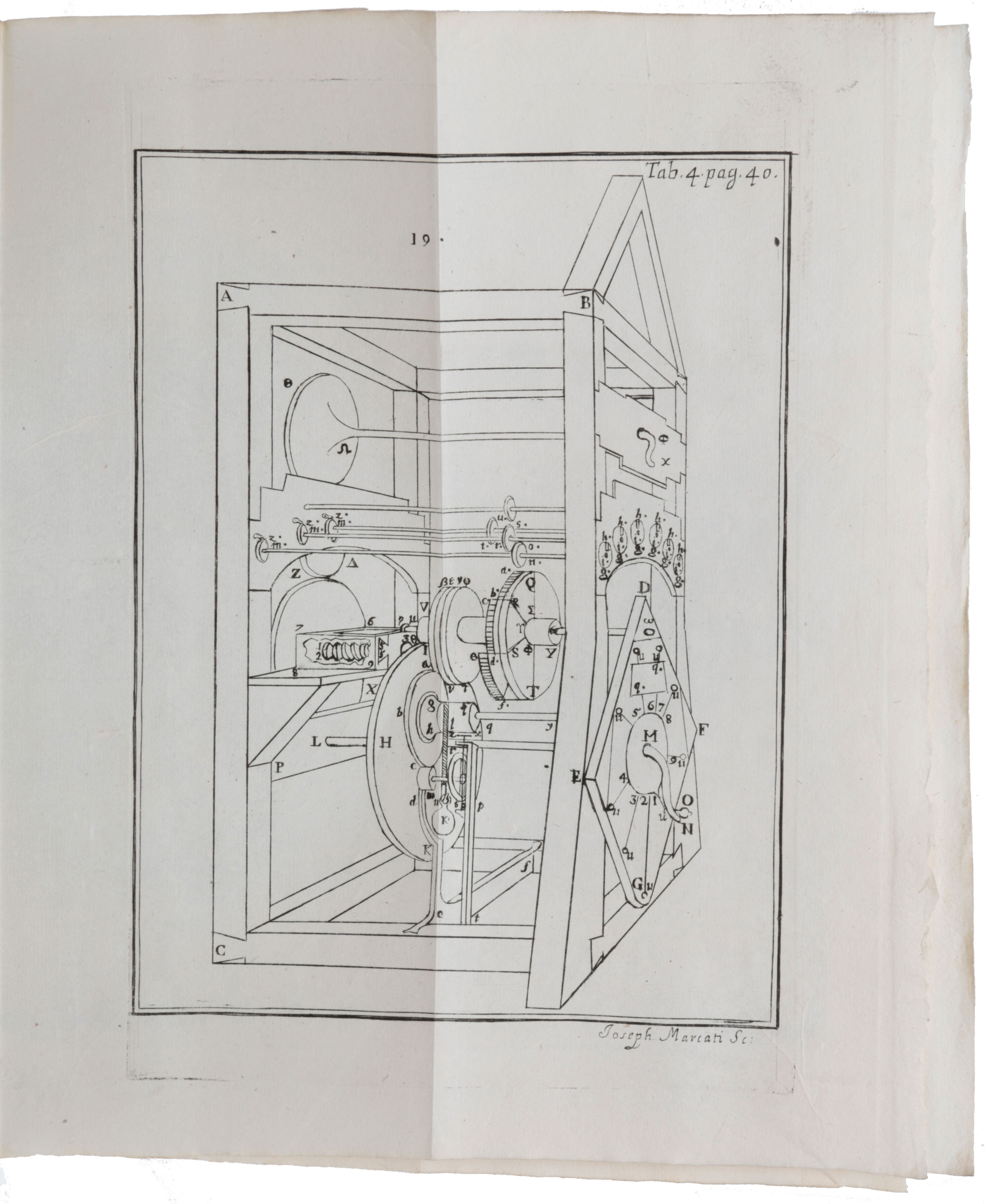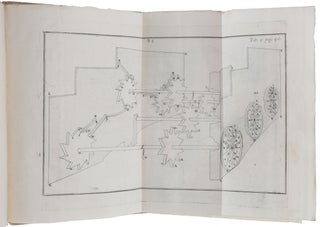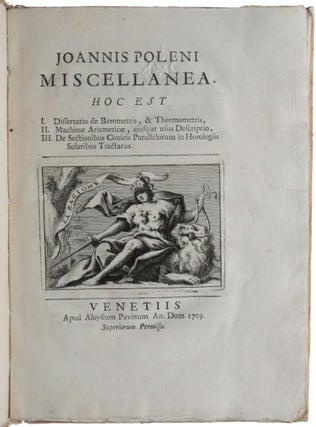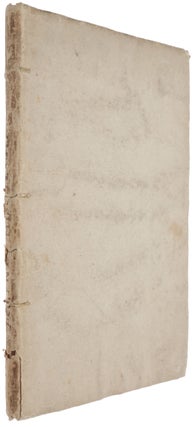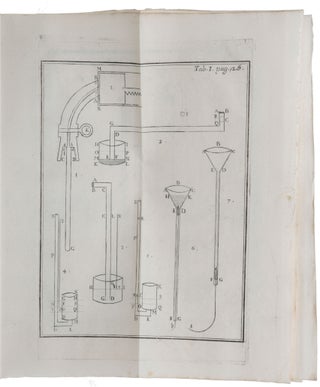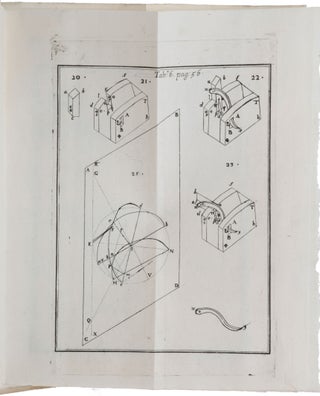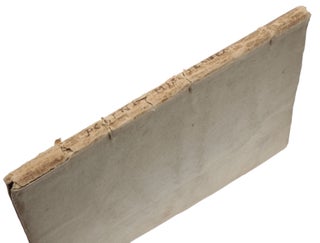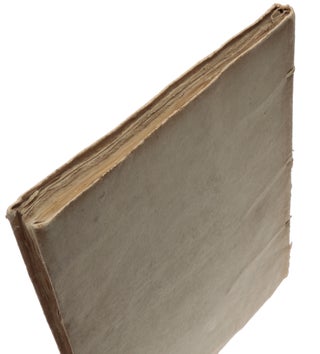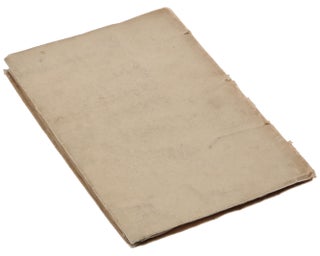Miscellanea. Hoc est I. Dissertatio de barometris, & thermometris. II. Machinae aritmeticae, ejusque usus descriptio. III. De sectionibus conicis parallelorum in horologiis solaribus tractatus.
Venice: Aloysius Pavinus, 1709. First edition of Poleni’s first book, the second part of which is a description of an early ‘arithmetical machine,’ or primitive calculator. Babbage had a copy of this work in his library. “Poleni’s earliest paper was Miscellanea: de barometris et thermometris; de machinaquadam arithmetiea; de sectionibus conicis in horologiis solaribus describendis (Venice, 1709). A treatise on assorted topics, it includes a dissertation on barometers … and on thermometers, in which several improvements are proposed; also included is the design of an arithmetic machine based on reports that Poleni had received of those of Pascal and of Leibniz. Poleni actually built this machine, which was reportedly very simple and easy to operate; but when he heard of another machine presented to the emperor by the Viennese mechanician Braun, he destroyed his own and never rebuilt it” (DSB). “Poleni’scalculator – in the shape of a big grandfather clock, in wood and iron – is a four-operation device, enabling the user to perform additions, subtractions (resorting tocomplement-to-nine additions), multiplications (by multiple additions), and divisions(by multiple subtractions). To perform multiplication and division Polenifollowed, independently, Leibniz’s idea of a device where multiplicand and divisorcould be stored and to be added or subtracted a fixed number of times. Differentlyfrom Leibniz’s ‘stepped drum’, the marquis conceived the ‘pinwheel’, a wheel with anadjustable number of teeth (0-9) that could be raised or lowered to set the figure to beoperated upon. Poleni’s machine had a three-sector wheel, thus enabling to set a three-digit figure, and a clockwork mechanism – with verge escapement – to drivethe entire machine by the energy of a falling weight. The pinwheel, albeit withdifferent design, was implemented in a number of calculators in the following threecenturies … Poleni’s Invention was acknowledged in Europe thanks to itsdescription published in 1727 in the first comprehensive review on mathematicalinstruments by Jacob Leupold [Theatrum arithmetico geometricum]” (Hénin, pp. 211-212). “Poleni gave a great boost to climatology and was among the first in Italy who had the courage to start regular meteorological observations after Galileo’s trial and the closure of the Accademia del Cimento. In 1709, with the help of Morgagni, Poleni built an improved air thermometer, Amontons’ type, and a barometer. The original Amontons thermometer had a spherical bulb inside which the sensitive air pocket expanded or contracted, giving a non-linear response depending on how much the spherical bulb section changed. Poleni understood the problem and adopted a cylindrical bulb, with constant section and linear response. Initially, Poleni made spot measurements from 1716. In 1724, he accepted an invitation from Jurin, secretary of the Royal Society of Medicine, London, and adhered to the network of the Royal Society (flourished from 1724 to 1735) and started an unbroken series of daily meteorological records from 1725 to 1761 including indoor air temperature (as requested by Jurin), pressure, precipitation, wind direction and weather notes” (Camuffo). Provenance: The Earls of Macclesfield (bookplate on front paste-down and embossed stamp on first three leaves). The second section of the Miscellanea describes the calculating machine of Poleni. The chapter opens with the following words: ‘Having heard several times, either from the voice, or from the writings of scientists, which were made by the insight and the care of the most illustrious Pascal and Leibniz, two machines which are used for arithmetic multiplication, which I do not know the description of the mechanism, and I do not know if it was made manifest, I wanted and guess with thought and reflection to their construction, to build a new one that implement the same purpose.’ “Then Poleni continues: ‘By a happy chance, I designed a machine with the use of which even a novice in the art of calculation, provided that knows the figures, can perform arithmetic operations with his own hand. So I am worried that it was made of wood, as I had planned and that, although initially built with poor precision, showed that this was achievable, rather than made. Therefore, I have recreated the machine from scratch, building it of the hardest wood, with all possible attention and the work done has not failed in vain.’ “So, according to the inventor himself, two wooden copies of the machine were made, but unfortunately none of them survived to the present time. “The first biographer of Poleni, the Frenchman Jean de Fouchy Pajil Grandjean, claims in his 1762 book ‘Eloge de Jean POLENI, Marquis du St. Empire, (né 1683 mort 1761)’, that ‘having heard that Mr Braun, a famous mechanic in Vienna, presented a similar machine to the Emperor, Poleni destroyed his machine and no more wanted to rebuild it.’ The same story is repeated in the two later Poleni’s biographies … Despite the fact that Fouchy was in strict contact with Poleni (when alive) and knew him personally, this story is quite questionable, not only because it is not compatible with the gentle character of Poleni … “The mechanism is set in motion by means of the weight, tied to the end of the rope, which is wound over the cylinder. The most important element of the machine – the so-called pin-wheel, was invented probably by Poleni (it is known that Leibniz has a similar design in one of his manuscripts, and that Leibniz and Poleni had a correspondence) … Actually in the machine are placed 3 pin-wheels, which means, that the input mechanism has only 3 digital positions. “The pin-wheel of Poleni actually is a smooth wheel, with attached to it a sector with 9 blocks. Each block contains a body, a tooth, and a small rod. There is also a fourth element of the block – a small spring. In the assembled block, the tooth can be erected outside of the block, if the rod is pressed by the operator or hidden in the body of the block, if the rod is released. Thus in each one of three sectors with blocks can be set from 0 to 9 erected teeth. When the tooth is erected, it will engage with the calculating mechanism during the revolution of the calculating mechanism, otherwise not. “The output mechanism consists of six dials, i.e., it has six digital positions. The tens carry mechanism use a one-tooth wheel and obviously has not been designed well, because it caused problems (it can happen that the machine stops in the middle of a tens-carry step due to adverse leverage forces.) “An additional crank was used for shifting the pin-wheel mechanism by one place at a time with respect to the transfer tooth wheels, thus allowing the multiplicand to be multiplied by the multiplier in higher places. “As a whole, despite the innovative idea of Poleni for the pin-wheel, which became an extremely popular constructive element of calculating machines some 150 years later, his machine looks rather rough and ill-formed device, as compared to the machine of his successor – Anton Braun” (https://history-computer.com/giovanni-poleni/). “Poleni was the son of Jacopo Poleni and carried his title of marquis of the Holy Roman Empire, conferred by Emperor Leopold I and confirmed in 1686 by the Republic of Venice. In his early life he followed a variety of studies, and his intellectual endowment was soon known to be extraordinary. After completing his studies, first in philosophy and then in theology, at the school of the Padri Somaschi in Venice, he began, with his parents’ encouragement, a judicial career. At the same time his father introduced him to mathematics and physics, and it became clear that the natural sciences were going to be his most prominent field of activity. “At the age of twenty-six he married Orsola Roberti of a noble family of Bassano del Grappa and accepted the chair of astronomy at the University of Padua; six years later he became professor of physics as well. The Venetian Senate invited him to investigate problems of hydraulics pertinent to the irrigation of lower Lombardy, Poleni soon acquired such proficiency in this field that he became the accepted arbiter of all disputes between states bordering on rivers. In 1719 he assumed the chair of mathematics at the University of Padua left vacant by Nikolaus I Bernoulli, upon the latter’s return to Basel. His noteworthy opening lecture was published in 1720 as De mathesis in rebus physicis utilitate. “In 1738 Poleni established within a few months an up-to-date laboratory of experimental physics and began to lecture on that subject. He simultaneously conducted meteorological observations, corresponded with French, English, German, and Italian savants (particularly Euler, Maupertuis, the Bernoullis, and Cassini III), published memoirs on various subjects, and participated in the study of calendar reform that had been sponsored by Pope Clement XI. In 1733 Poleni received a prize from the Royal Academy of Sciences of Paris for a paper on a method of calculating – independently of astronomical observations – the distance traveled by a ship; and in 1736 he was awarded a prize for a study of ships’ anchors. In 1739 he became a foreign member of the Academy, and in 1741 he received a prize for a study of cranes and windlasses. “Poleni’s scientific activities were paralleled by classical researches, which were described in treatises on the temple of Ephesus, on ancient theaters and amphitheaters, on French archaeological findings, on an Augustan obelisk, and on several architectural topics. In 1748 he was called to Rome by Pope Benedict XIV to examine the cupola of St. Peter’s basilica and to propose means of preventing its further movement, but he was soon recalled to Padua to assume judicial duties. Excessive work gradually affected his health, although not his enthusiasm, until his death at the age of seventy-eight. His remains were laid in the Church of St. Giacomo in Padua, where his sons placed a monument in his honor. The citizens of Padua subsequently decreed that a statue (one of the earliest works of Antonio Canova) of Poleni be placed among those of illustrious men in the Prato della Valle. A medal in his honor was struck by the Republic of Venice” (DSB). Riccardi ii, 290. Camuffo, ‘Galileo’s revolution and the infancy of meteorology in Padua, Florence and Bologna,’ Méditerranée [online], Paléo-environnements, géoarchéologie, géohistoire, (http://journals.openedition.org/mediterranee/12565). Hénin, ‘Early Italian computing machines and their inventors,’ in: Tatnall, Reflections on the History of Computing: Preserving Memories and Sharing Stories, AICT-387 (2012), pp. 204-230.
4to (240 x 173 mm), pp. [viii] 56, with engraved allegorical title (‘Reason taming the savage beast’) and 9 folding engraved plates by Joseph Marcati. Contemporary paste-boards (spine worn, small piece chipped away).
Item #5800
Price: $12,500.00

